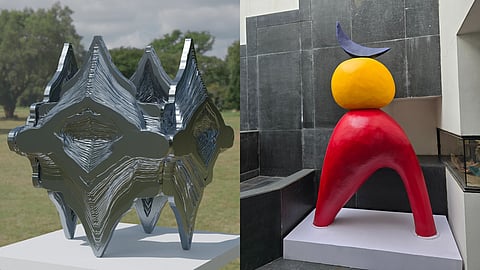
- HOMEGROWN WORLD
- #HGCREATORS
- #HGEXPLORE
- #HGVOICES
- #HGSHOP
- CAREERS
- ABOUT US
- CONTACT US

Art Mumbai’s Sculpture Park showcases South Asian women artists reshaping contemporary sculpture by emphasising labour, vulnerability, and ecological issues. Located at Mumbai’s Mahalaxmi Racecourse, the works assert feminist presence and honour artists like Madhvi Parekh and Shanthamani Muddaiah, extending their legacy of material knowledge and resistance to hierarchy.
Mumbai’s connection with Indian modern art runs deep, going back to the Progressive Artists’ Group founded in 1947, which helped define India’s modern art movement. The city’s cultural vibrancy extends across performing arts, fashion, music, and literature, cementing its status as a centre of creative innovation. In recent years, Mumbai’s art scene has grown considerably, with an increase in gallery activity, landmark exhibitions, and public programmes that have brought art into the city’s everyday spaces. Art Mumbai builds on this legacy, serving as a platform that unites artists, galleries, institutions, curators, collectors, architects, designers, collectors, and art enthusiasts.
This year, Art Mumbai expands with the inclusion of a sculpture park at the Mahalaxmi Racecourse. These works, dispersed across the iconic racecourse, demonstrate how women artists today are expanding the sculptural vocabulary beyond the canonical logics of monumentality, permanence, and heroic form. Instead, they embody an ethos of material intimacy and collective memory, prompting a reconsideration of what public sculpture can be and whom it serves.
Located across the expansive Mahalaxmi Racecourse, the Sculpture Park offers visitors an immersive experience where large-scale installations are complemented by intimate, tactile interactions. This curatorial focus on women artists brings together both pioneering and emerging talents whose works reimagine space, scale, and materials. Exploring themes of identity, labour, migration, reclamation, and collective memory, the sculptures—crafted from ceramics, steel, bronze, fibreglass, mixed media, and found objects—demonstrate the resilience and creativity shaping contemporary sculptural practices.
To contextualise this moment in India's modern art history, one must look back to Meera Mukherjee, whose distinctive engagement with bronze expanded its expressive potential and foregrounded labour — both artisanal and corporeal. Her practice refused the separation between artist and craftsperson, collapsing hierarchies of value. Many artists featured at the Sculpture Park extend that legacy not through stylistic citation but by pushing Mukherjee’s radical proposition: that sculpture emerges from the lived conditions of its making.
At the same time, Shanthamani Muddaiah’s experiments with unconventional materials—charcoal, paper pulp, industrial residue—speak to a world marked by extraction and ecological precarity. Sudipta Das and Tayeba Begum Lipi transform the domestic and the discarded into tensile structures of care, migration, and gendered resilience. Others, like Adeela Suleiman and Shambhavi Singh, confront political violence and agrarian histories through material metaphor, shaping steel or agricultural detritus into critique. Each method foregrounds labour as memory of bodies, communities, and diasporas.
The outdoor environment heightens these concerns. Unlike sculpture confined to galleries, these pieces are affected by weather, elements, and light. Visitors move through them rather than observe from specified locations, engaging in what Korean curator and art theorist Miwon Kwon refers to “relational geographies” — spaces shaped by experience rather than fixed coordinates.
This is particularly resonant in Mumbai, where land is contested and visibility uneven. Here, these women artists make spatial claims that defy erasure: their works occupy ground. The exhibition’s multigenerational span—from Meera Mukherjee and Madhvi Parekh’s pioneering practices to younger voices like Tarini Sethi and Vinita Mungi—articulates a continuum still underwritten by systemic gaps in recognition and institutional support. Yet the Sculpture Park signals a shift: today, South Asian women are not merely included within sculptural discourse; they are reshaping its material thresholds and conceptual ambitions.
ART MUMBAI, presented by Birla Opus Paints, returns for its third edition from 13 to 16 November 2025 at the Mahalaxmi Racecourse. Follow ART MUMBAI here.
If you enjoyed reading this, here’s more from Homegrown:
Femininomenon: Meet The 20th Century Women Who Shaped Modern Indian Art
In 'Myth, Memory, Meaning' Four Indian Women Artists Explore The Politics Of The 'Self'
The Life Of Ambika Dhurandhar: The First Indian Woman To Graduate With A Fine Arts Degree
